Comics: Zack Comics
Compiled by Martin Willey
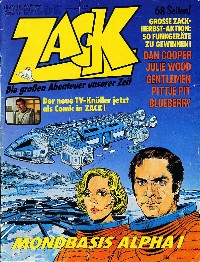
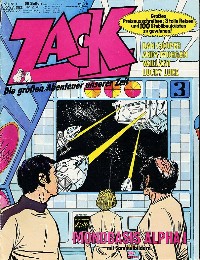
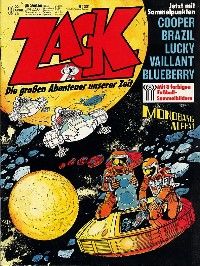
Published by Koralle-Verlag in West Germany (German text). Cover prices show the comic was also available in German speaking Austria and Luxembourg, German speaking regions of Switzerland and Italy, the neighbouring countries of Denmark and the Netherlands, and (perhaps for Germans on holiday) Spain.
Zack comic was launched in West Germany in April 1972. Initially weekly, then every fortnight, it introduced German readers to the Franco-Belgian comic tradition, and especially the best adventure comic strips (the comic slug, from 1976, was "The Great Adventures of Our Time"). The strips were categorised:
Most of the strips were reprinted and translated from the Belgian comic TinTin and the French comic Pilote, with some from Italy, such as Corto Maltese and Gentlemen Gmbh (in the original Italian, Gli Aristocratici, the aristocrats). Zack also commissioned a few strips themselves, notably Turi & Tolk.
Following the European comic tradition, Zack also published comic albums ("Zack Box") with one complete story. They also published compilation paperbacks with different strips, each with a complete story, called "Zack Parade".
In 1979, publisher Koralle expanded into Belgium and the Netherlands with Wham and superAS, but the Franco-Belgian publishers had withdrawn their licensed strips. In 1980 there were editions in Finland (Super S), Sweden (SM Special) and Denmark (Zack); there had already been a version in Finland called Zoom from 1973-1974. Zack and the international editions ended in 1980. The brand was revived in 1999 by another publisher.
Zack issues were numbered by year and week, resetting to 1 at the start of each year (like Look-In in the UK). Each issue had around 50 pages (68 pages from 1976) with a mix of different strips. In addition there were a few features and competitions, including, from 1976, the "Zack Club" encouraging readers to interact with the comic. The adventure strips were each 9-10 pages per issue, serialized over several issues.
TV tie-in comics were rare in European comics, but Zack made an early impact in October 1972 when they reprinted some Star Trek strips from Gold Key in the US. While the art had to be reformatted and the quality was far inferior to the French-Belgian strips, it was popular with readers. Later they did a strip based on Kung Fu.
For Space: 1999, Zack commissioned their own strip, using the Spanish artist Cardona (José Maria Cardona Blasi, born 1954). Cardona worked for the art agency Selecciones Ilustradas (other Spanish artists who worked with the agency include Vicente Alcazar, Adolfo Buylla and Carlos Pino, all of whom worked on the Charlton US comics). The stories were written by Fariñas.
The series was known by the German title, Mondbasis Alpha 1 (Moonbase Alpha 1), but normally abbreviated on covers to "Alpha 1".
Koralle, publisher of Zack, collaborated with the Italian publisher AMZ. The copyright notice alongside each Zack strip notes "mit Genehmigung von AMZ editrice/Milano"/"with authorization of AMZ editions, Milan". Presumably the companies licensed Space: 1999 from ITC together and then shared their efforts.
The Space: 1999 strips were also based on the first series, mostly closely following the storylines of episodes. The art was very faithful, with some frames copied directly from how they appeared on screen. Character likenesses were excellent. Even the supporting cast are recognisable (ITC had explicitly ordered Charlton in the US not to use the likenesses of Carter, Morrow and Sandra).
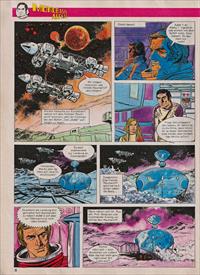
Dramatic and accurate art from Zack 1978 issue 20, based on Earthbound. Difficult subjects such as the Eagles are drawn well, although later stories make obvious use of the Airfix Eagle as the model. Space scenes were dramatic and colourful.
The main problem are the plot-heavy stories, full of dialogue and blocks of text exposition. Together with a tendency to rely on character heads, rarely taking more varied perspectives, it leaves the layout looking pedestrian. Occasional character action frames are a little stiff and awkwardly posed. The backgrounds don't look much like Moonbase Alpha, with generic instruments and tape reels behind the cast.
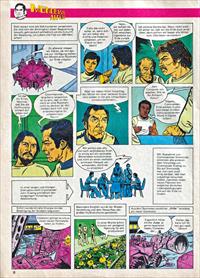
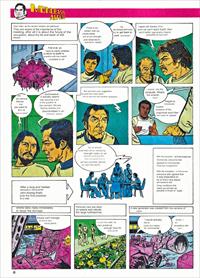
Art from Zack 1978 issue 20, based on Breakaway and Earthbound. The opening command conference from Earthbound became a concluding discussion to the events of Breakaway. Simmonds suggests another explosion to take the Moon back to Earth orbit, but everyone else votes against him. There are some nice vignettes showing Moonbase Alpha being repaired, and the hydroponics being repaired to feed them. This is directly adapted from the AMZ novelisation by Gianni Padoan.
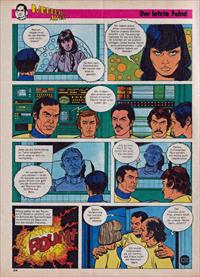
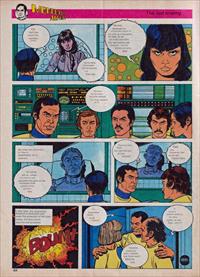
Art from Zack 1978 issue 7, based on The Last Enemy, German and English translation. The comic strip follows the original episode storyline, with Koenig simply giving Talos the co-ordinates of the Satazius; Talos blows up Dione is a single frame. The TV episode was re-filmed with new scenes to fix this unexciting ending. The comic art is closely based on photos of the episode, particularly of Dione (here named Diane).
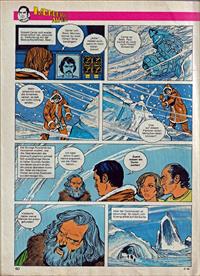
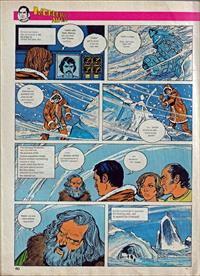
Some changes to this adaption of Death's Other Dominion in Zack 1978 issue 10. The Alphans wear winter coats rather than the blue ski suits, there's some action as Carter goes out to clear the Eagle antenna, and there is a wide view of the exterior entrance to the ice cave.
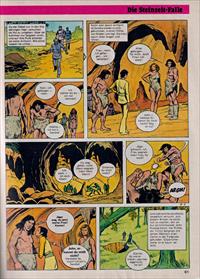
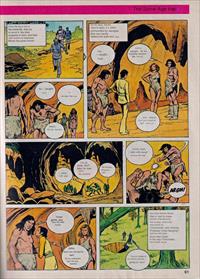
A freer adaption of The Full Circle, from Zack 1978 issue 12. The cave people are talking, Alan is rescued from the pit by Bergman.
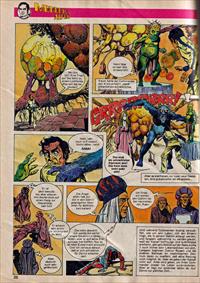
Art from Zack 1977 issue 21, based on Missing Link. Koenig's nightmare is here a weird landscape and different monsters, while we see two more Zennites with Raan. Many of the earlier strips resort to text boxes like this, to get through all the necessary plot exposition ("Doctor Russell and the other caregivers in medical centre slowly begin to doubt that his rescue is still possible. But they don't give up the fight. Everything is being done to bring their commander back to life. But he just seems to be lying there lifeless."). Later strips are better at telling the story through the art.
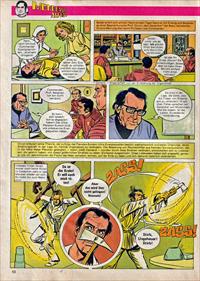
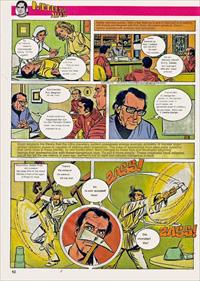
Art from Zack 1977 issue 25, based on Dragon's Domain. The story is completely restructured and told chronologically, with no flashbacks. The Ultra mission happens after the breakaway, attempting to find a habitable planet. Cellini is named "Selder" (based on the original scripted character name, Calder). Dixon is a genetics professor on Moonbase Alpha, not a space commissioner on Earth. In these scenes, Koenig is sceptical of Cellini/Selder, but Dixon is supportive. Dixon thinks the aliens from the ships have mutated under radiation.
Copyright Martin Willey